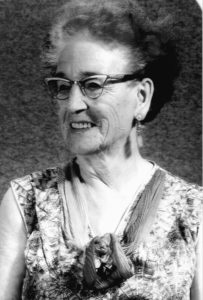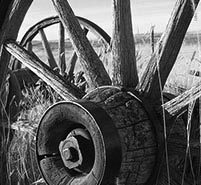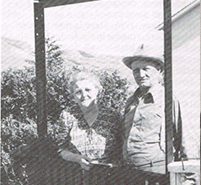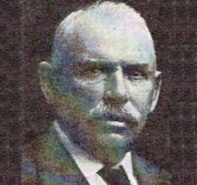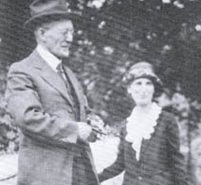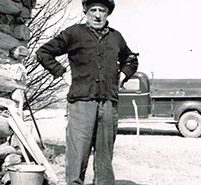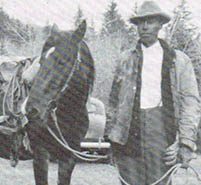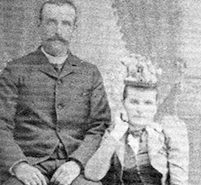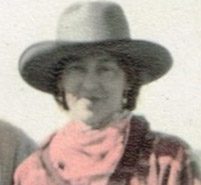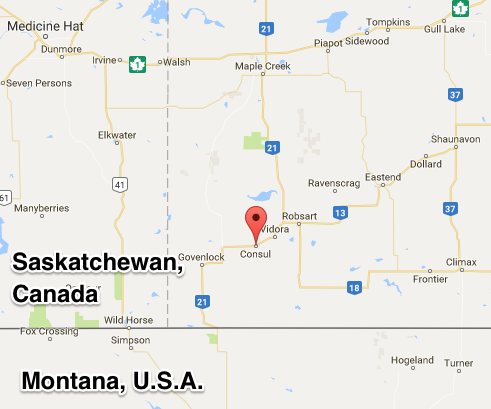Frances (Gaff) Paterson
Source: Frances (Ma Pat) in From Sage to Timber history book
James Aaron Gaff was born in Indiana in 1852. He and his first wife had three youngsters, Dennis “Bub”, Carrie and Etta. His mother had been married twice as he spoke of his half-brother, John K. Gray.
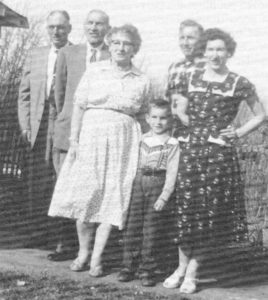
George Paterson family – Jimmy, George, Ma Pat, Roy, Meda & grandson, Perry Paterson / Photo From Sage to Timber
In 1894 Dad Gaff sold the first home I can remember, which was about 80 miles south of our nearest town, Alliance, Nebraska. This house was made of sod. The only means of heating was burning buffalo and cow chips. All the buildings and corrals were also of sod. Dad’s reason for selling out was because there was getting to be so much horse and cattle rustling. He decided to head for Canada, with Pincher Creek, Alberta in mind as my Uncle Walter Shafer was there and had written for us to come as it was a grand country. When leaving the USA the Gaff family consisted of Dad, Mother, Bub, Carrie, Etta, Myra, myself, Alla, Jimmy, Estys and Eva, nine months old and still in the three-cornered pin up stage with Estys not far from it.
What a journey it must have been for Mother! One would think the covered wagon would be equipped with a clothes line. We began the trip with two covered wagons, a four-horse team on each and several saddle horses. Dad drove one team and Etta the other. Bub was to join us later. We girls took turns on horseback, keeping the loose horses with the wagons.
After two days on the trail, Mr. Theodore Minor, who was married to our sister, Carrie, caught up to us on horseback to tell us some crooks might overtake us as they knew we were carrying a large sum of money. I can remember Dad having a big gun handy. Mother was more at ease after we arrived at a relation’s place by the name of Charley Gettys.
After a few days journey we came to an old friend’s place, Mr. Hill. There they had a team of dandy large horses, just what Dad wanted for a wheel team so he bought them. At this same place was a hired hand, John Boon, a very good teamster. Dad wanted him to come to Canada with us, but Mr. Hill would not let him go until the potatoes were planted. We kids, taking a liking to John, helped put the potatoes in the ground. In order to get rid of all of them before dark we dug holes and put pails full in, knowing by the time they came up we would be in Canada.
About halfway to Canada we saw our first rocks. We carried them in the wagon for days, but not for long, as we later saw plenty of rocks.
When we first came to Canada there wasn’t a fence line between Havre, Montana and the NWMP Detachment at Ten Mile on Battle Creek where we first landed. Then the grass on the prairie was a foot high, all sloughs were full of water and mosquitoes were bad; the horses would come for miles to stand in the smudges, especially in the evenings. With so much long grass prairie fires were very hard to put out; green cowhides were used to smother the flames. The good grazing didn’t last too long after the ranchers began increasing their herds.
The Battle Creek District took Dad’s eye so we settled on the creek a few miles north of the old Lindner Place which is now owned by Ben and Jim Mitchell. The men were very busy building a house, barns, shed and corrals and haying. The hay was hauled from the Cypress Hills Bench; it was called prairie wool, not a very good quality of feed.
Walter Shafer came from Pincher Creek and lived with us for a few years. He and Dad bought our first cattle from Mr. Good who lived near where the town of Walsh, Alberta now stands. While branding these cattle with the old JON brand Dad had the misfortune to break a leg. Walter’s brand was UOR.
After a few years on this place Dad moved to another place about ten miles down Battle Creek and applied for a five mile long irrigating scheme. This work was done by man and horsepower and backbreaking slip scrapers. In later years the Fresno scraper came out which was dumped by pulling a rope. Horses working all summer at this would be quite thin. After freeze-up they would be turned on the prairie to winter and when brought back in the spring they would be very fat.
After helping get the JON Ranch built up, John Boon joined the NWMP as a four-horse teamster, to haul supplies from Maple Creek to Ten Mile Detachment. He later married Etta. They had a family of four. After leaving the police force they moved to Millet, Alberta and lived there for several years. One day John took a team and sleigh to Millet for supplies. He had the sleigh loaded with groceries and clothing for the family and was ready to leave for home. He just seemed to disappear and has never been seen since.
In the next five years or so we had plenty of sorrow. My brother, Jimmy, age eight, had the misfortune to be kicked behind the ear by a horse and died instantly. From the shock my mother lost baby Ellis at birth. Then a year later Mother, not yet over the shock, died when little Madge was born. Madge was a sweet little girl of five years when, alone in the house, her clothes caught on fire. She ran out to the blacksmith shop where Dad was working. The burn and shock were more than she could stand; she died in Maple Creek the next day. A few years later, Uncle Walter Shafer passed away at Eastend.
Myra married Morris Ross. They had one daughter. In 1940 Morris died. Estys married Jack Osborn, better known to the old-timers as “Dakota Jack”. They first lived in North Dakota then later moved to Littlefork, Minnesota where Jack passed on. Several years later Estys married Halvor Odegard.
After Bub Gaff married Vienna Mae Pettyjohn, better known as “Honey”, he and Dad dissolved partnership. Then Bub and family lived at Flapjack Creek, a few miles south of old Fort Walsh. They raised a family of six. When the old Maple Creek Hospital burned down Bub, along with nine other patients, suffocated before they could be rescued. Honey continued to live at the Flapjack Place with most of her family close by.
Dad, Alla and Eva lived on the JON Ranch for a few years then Dad bought the Govenlock Hotel from John Lindner. He and Alla lived there and Eva continued living at the ranch. Alla married Andy McRae and Dad stayed with them until 1941 when he passed on. Allie died of cancer the same year.
In October 1909, George Paterson and I were married and lived all our lives on Battle Creek near Ten Mile. We had three youngsters – Jimmy, Roy and Meda. Jimmy and Roy bought the home place and are now in partnership. Jimmy now lives on the home place; he has one son, Keith, who at the present time is in Egypt with an oil company. Roy, his wife, Ellen and son, Perry, live on the old B.A. Jahn Ranch a few miles north of Govenlock.
George passed away after an operation in Swift Current Hospital in November 1960. I am living in my own home in the yard of my daughter, Meda, and son-in-law, Lyle Wilson. I see my great-grandchild and grandchildren every day and still live right beside good old Battle Creek. My great-grandchild’s name is David George Wilson.
Note: The preceding story was written by Frances (Ma Pat) in about the year of 1967. Since that time…
- Myra Ross passed away on November 23, 1971 at the age of 85.
- Eva Gaff passed away on May 10, 1976 at the age of 81.
- Frances (Ma Pat) passed away on September 12, 1976 at the age of 89.
- Etta Boon passed away in 1980 at the age of 98.
- Honey Gaff passed away on May 26, 1980 at the age of 75.
- Estys Odegard passed away on February 15, 1982 at the age of 87.
- Jimmy and Roy sold their ranch in 1967. Jimmy’s son, Keith, went to Arizona to live.
- Meda Paterson lives in Medicine Hat, Alberta.

